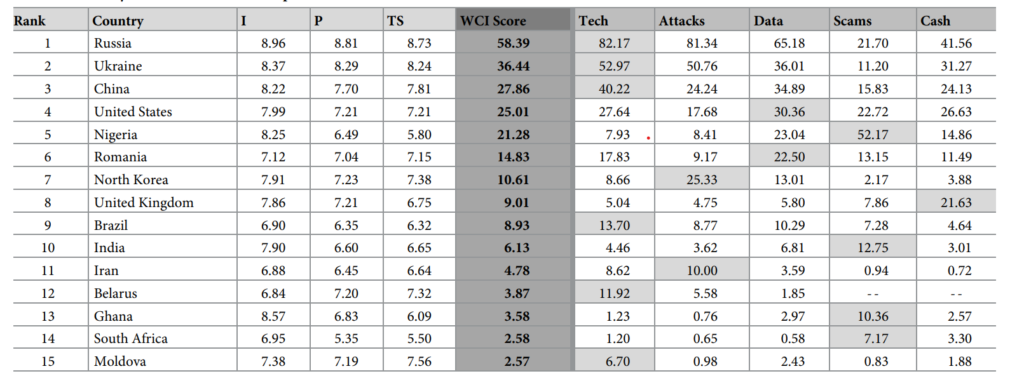The estimated costs of cybercrime range from hundreds of millions to trillions of dollars, making it a major global concern. Cybercrime continues to be a widespread concern despite its invisibility. A global survey of the world’s leading authorities on cybercrime yielded the data used for the Index.

The findings indicate that the biggest threats from cybercriminals are concentrated in a limited number of nations. The countries that routinely place in the top ten for each category of cybercrime are Russia, Ukraine, China, the US, Nigeria, Romania, North Korea, the UK, Brazil, and India.
Among the five categories were:
1. Technical goods and services (viruses, for example)
2. Assaults and blackmail
3. Identity and data theft (such as by phishing or hacking)
4. Scams (such as fraudulent internet auctions or company email compromises)
5. Money laundering and cashing out (credit card fraud, for example)
Summarising the report
Cybercrime is a significant global challenge with potential costs reaching trillions. Offenders hide behind online personas, making it difficult to track them. An expert survey was conducted to identify the geographical locations of cybercriminals, revealing that a few countries are major sources of cybercrime. This information can help law enforcement and policymakers combat this threat effectively.
It is mainly unknown where cybercriminals are located and how prevalent cybercrime is in any nation. Due to the lack of reliable data on the geographic location of offenders, developing a reliable measure of cybercrime is challenging. Creating a cybercrime measure could aid in focusing efforts on hotspots and locating potential hubs for cybercrime. This may also benefit academic research and theoretical discussions on cybercrime.
Result

I = Impact; P = Professionalism; TS = Technical skill, Technical = Technical products/services, Attacks = Attacks and extortion, Data = Data/identity theft, Cash =Cashing out and money laundering. I, P, and TS are scored out of 10. ‘WCI Score’, and all columns following, are scored out of 100. Each country’s top score across all cybercrime types is shaded in grey.
A survey was conducted with 147 individuals out of 245 contacted, resulting in a 37.5% response rate. The survey collected information on participants’ nationality and residence, with uneven representation across the five major geopolitical regions. Participants included experts from Africa, the Asia-Pacific, Europe, North America, and South America. The detailed breakdown of participants’ information can be found in the Supporting Information document.

Romania routinely appears in the top three rankings for cybercrime; similarly, the top 10 countries for technological products/services and attacks/extortion indices appear in varied orders. All five regions are represented in the survey, which demonstrates a broad geographical diversity while having a short list of recurring cybercrime hotspots. Experts identified 97 countries in total; differing numbers of countries were nominated in different areas of cybercrime.

India, with a score of -6.02, is notable among the countries examined in this analysis for the frequency of scams, but overall, it takes a balanced stance. However, as evidenced by their relative scores of 10.41 and –2.62, which tend to approach zero, Romania and the USA succeed in both technological and non-technical crimes. This demonstrates the uniqueness of every nation by highlighting their own traits in the context of criminal activities.
Conclusion
This study highlights geographic hotspots of profit-driven cybercrime with the creation of the World Cybercrime Index through the use of an expert poll. It analyses differences in cybercrime production between nations and offers insights to counter this dynamic danger by identifying centres specialising in different types of cybercrimes.


